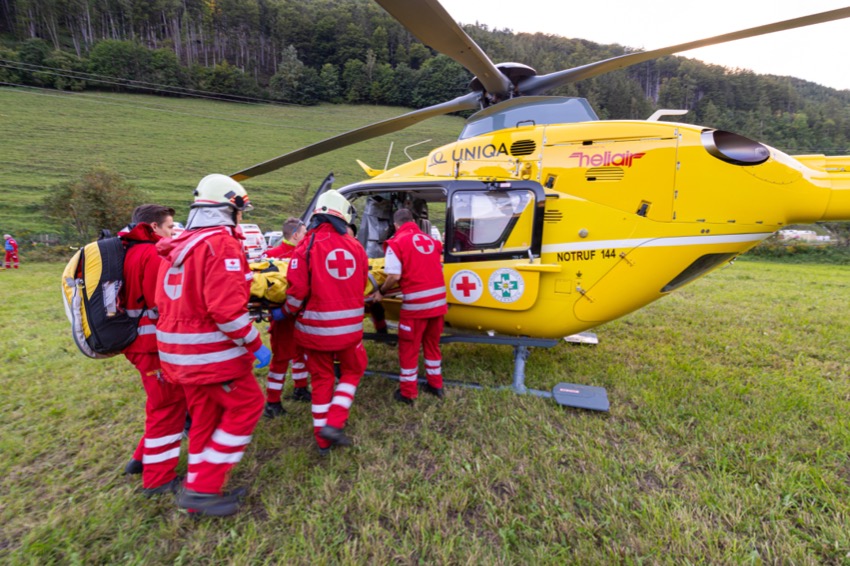Disaster preparedness among neighbours in the Alps
Every year, Austria is home to around 40 minor earthquakes. The country also risks major earthquakes of a magnitude of up to 7+ on the Richter scale, particularly along the alpine mountain range bordering with Hungary. The thousands of people who live in or near this area would need support if a disaster were to strike.
To better prepare for such scenarios, a consortium led by the Austrian Red Cross launched the IRONORE 2019 project, co-funded by the European Commission’s Directorate-General for European Civil Protection and Humanitarian Aid Operations (DG ECHO). IRONORE 2019 aimed to test joint response capacities in the framework of the Union Civil Protection Mechanism in the Alps, through a discussion-based exercise and a full-scale civil protection simulation conducted in Eisenerz, in the Styria state in southeast Austria.
“Austrian Red Cross Units worked together with the fire department and other emergency response teams, including from other European countries, to manage this scenario. It was nice to see how things intertwined, and how activities that were developed on paper were tested in a real-world simulation”, explained Gerry Foitik, Federal Rescue Commander of the Austrian Red Cross.
The Austrian Red Cross plays a key role in disaster management across the country, including through the provision of medical services and humanitarian aid. Another member of the consortium, the Hungarian Red Cross, is also a key national partner in the field of civil protection, maintaining disaster response units to organise relief aid and ensuring material and legal assistance for people affected by these kinds of emergencies. For IRONORE 2019, the Austrian Red Cross and the Hungarian Red Cross collaborated with “Disaster Competence Network Austria” – a research platform on national and international disaster management, and the “iHELP institute” – a Polish non-profit organisation which focuses on rescue operations and humanitarian crises.
As part of the project, Eisenerz became a training centre for international rescue teams in a full-scale exercise that lasted three days. Over 400 Red Cross staff and volunteers, as well as 1,000 participants from Austrian, Hungarian, and international rescue organisations, took part in the exercise. IRONORE put together operational teams from Slovenia, Hungary, Germany and Austria. An EU Civil Protection team consisting of experts from Sweden, Spain, Greece, and France was also deployed. The exercise included 30 different emergency scenarios caused by a fictitious earthquake, from a bus accident, to a train derailment, to the landslide of a compound camp.
The scenario was framed as follows: a 6.8 magnitude earthquake occurred in Eisenerz on 11 September 2019. Its main consequences were massive infrastructural damage, affecting 15,000 people – over 1,000 dead, 300 trapped in the rubble, and 4,300 left homeless and without electricity, water, and food. The local branch of the Austrian Red Cross, the fire brigade, and the police department were all heavily affected themselves, and external assistance was needed, including from the European Union Civil Protection Mechanism.

The objectives of IRONORE 2019 were three-fold. First and foremost, it aimed to improve civil protection procedures and establish a common understanding of cooperation in this context. Secondly, it sought to enhance earthquake response activities. Thirdly, project coordinators tested their interoperability by using the Styrian government’s command and control system to be as well prepared as possible for a disaster in the region.
“Colleagues from National Red Cross Societies from neighbouring countries participated in this exercise in Austria. But maybe tomorrow, it will be our turn to assist our colleagues if something happens in Slovenia, for example. It is therefore important that we have previously worked together, and know each other’s working modalities”, said Peter Hansak, State Rescue Commander for the Austrian Red Cross in Styria.
In September 2020, project partners hosted the online International Civil Protection seminar to analyse the simulation exercise and exchange insights into different civil protection processes, as well as national and international developments in the field. Jose Almodovar-Araez, DG ECHO’s Desk Officer for the project, commended the high bar that IRONORE had set and the virtual reality technologies and field scenarios it had pioneered. The seminar emphasised the value and necessity of cooperation across countries when it comes to Civil Protection measures. According to Dr. Brigitta Sáfár, Head of Disaster Management at the Hungarian Red Cross, “Coordination is the key to effective response.”
Overall, IRONORE 2019 was effective in improving cooperation between neighbouring countries in managing the consequences of potential future natural disasters in the alpine region. Feedback from participants, trainers, observers and actors who took part in the exercise underlined how the different milestones helped them to be better prepared to work together efficiently in the future. Exercises like IRONORE will do a great deal in making Europe a safer place and support cross-border cooperation.

Basic information
Activity name
IRONORE 2019
Country
Austria
Duration
January 2019 – September 2020
Partners
Austrian Red Cross, Hungarian Red Cross, iHelp Institute, Disaster Competence Network Austria, European Commission Directorate-General for European Civil Protection and Humanitarian Aid Operations (DG ECHO)

